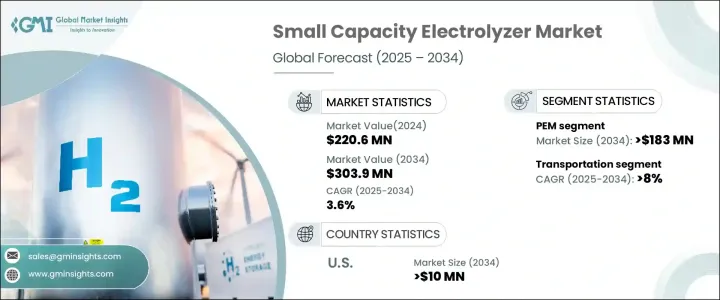
세계의 소용량 전해조 시장은 2024년에 2억 2,060만 달러로 평가되었고, 2025-2034년 CAGR 3.6%로 예측되어 꾸준한 성장을 이룰 것으로 예상됩니다.
수전해를 이용한 이러한 소형 수소 생성 시스템은 연구, 소규모 산업 공정, 주택용 수소 제조, 수소 구동 기기의 연료 공급 등 다양한 국소적 용도에 필수적입니다. 중앙 집중식 인프라에 의존하지 않고 현장에서 수소를 생성할 수 있는 것이 채용의 중요한 추진력이 되고 있습니다. 청정 에너지로의 전환이 세계적으로 가속화되고 있는 가운데, 소용량 전해조는 분산형 수소 제조의 실행 가능한 솔루션으로 부상하고 있습니다.

에너지의 독립성, 지속가능성, 효율적인 수소 생태계 개발에 대한 관심 증가는 산업 전반 수요를 촉진하고 있습니다. 클린 수소 이니셔티브를 홍보하는 정부의 인센티브 및 정책은 시장 확대를 더욱 강화하고 있습니다. 게다가, 기술과 제조 공정의 발전으로 제조 비용 및 운영 비용이 절감되어 전해조가 더욱 친숙해지고 있습니다. 스케일업이 가능하고 다양한 셋업에 원활하게 통합할 수 있기 때문에 특히 탄소 중립 달성을 목표로 하는 산업이나 지역에 있어서, 그 매력이 높아지고 있습니다. 수소 기반 에너지 솔루션에 투자하는 기업은 소용량 전해조를 활용하여 효율을 높이고 화석 연료에 대한 의존도를 줄이고 이 분야의 장기적인 성장을 가속하고 있습니다.
| 시장 범위 | |
|---|---|
| 시작 연도 | 2024년 |
| 예측 연도 | 2025-2034년 |
| 시작 금액 | 2억 2,060만 달러 |
| 예측 금액 | 3억 390만 달러 |
| CAGR | 3.6% |
제품 유형별로, 양성자 교환막(PEM) 부문은 2034년까지 1억 8,300만 달러를 생산할 것으로 예상됩니다. PEM 전해조에 대한 선호도 증가는 높은 전류 밀도, 소형 구조 및 전압 변동에 대한 신속한 반응으로 인해 발생합니다. 에너지 및 변속기 손실을 최소화하고 비전화 지역에서 효율적으로 작동하는 능력은 특히 농촌 지역 및 원격 지역에 유리합니다. 멤브레인 재료와 촉매의 끊임없는 혁신은 PEM 기술의 내구성과 비용 효율성을 향상시키고, 시장 잠재력을 강화하고, 수소 경제 성장의 중요한 촉진요인으로 자리매김하고 있습니다.
용도별로는 운송 분야가 2034년까지 8%의 연평균 복합 성장률(CAGR)로 견조하게 성장할 것으로 예상됩니다. 수소를 동력원으로 하는 모빌리티 솔루션의 채용이 증가하고 있는 것이, 특히 연료 공급 인프라 개발에 있어서, 소용량 전해조 수요를 촉진하고 있습니다. 수소 공급망 강화 및 국제 무역 파트너십의 추진은 이 부문의 확대에 중요한 역할을 합니다. 이산화탄소 배출량 감축 및 지속가능한 에너지원으로의 이행을 위한 세계의 대처가 강화되고 있는 가운데, 분산형 수소 제조가 견인력을 늘리고 있으며, 미래의 수송 네트워크에서의 전해조의 역할은 더욱 견고해지고 있습니다.
미국의 소용량 전해조 시장은 2034년까지 1,000만 달러를 창출할 것으로 예상되며, 이는 지역 밀착형 수소 제조에 대한 투자 증가로 인한 것입니다. 기업과 정책 입안자가 에너지의 회복력과 배출 감축을 우선시하는 가운데, 시장은 도입의 급증을 목표로 하고 있습니다. 신재생 에너지 프로젝트 증가와 더불어 청정에너지 솔루션의 통합을 목표로 하는 기업의 노력이 수요를 더욱 가속화하고 있습니다. 지속가능성 목표를 달성하고자 하는 산업계는 효율적인 현장 수소 생성을 위해 소용량 전해조에 주목하고 있으며, 저탄소 경제로의 전환에서 중요한 구성 요소로서의 역할을 확고히 하고 있습니다.
The Global Small Capacity Electrolyzer Market, valued at USD 220.6 million in 2024, is on track to experience steady growth with a projected CAGR of 3.6% from 2025 to 2034. These compact hydrogen generation systems, utilizing water electrolysis, are becoming essential for various localized applications, including research, small-scale industrial processes, residential hydrogen production, and fueling hydrogen-powered equipment. Their ability to generate hydrogen on-site without dependence on centralized infrastructure is a key driver of adoption. As the transition to clean energy accelerates worldwide, small capacity electrolyzers are emerging as a viable solution for decentralized hydrogen production.

The increasing focus on energy independence, sustainability, and the development of efficient hydrogen ecosystems is fueling demand across industries. Government incentives and policies promoting clean hydrogen initiatives are further boosting market expansion. Additionally, advancements in technology and manufacturing processes are reducing production and operational costs, making these electrolyzers more accessible. The ability to scale and integrate seamlessly into different setups enhances their appeal, particularly for industries and regions aiming to achieve carbon neutrality. Companies investing in hydrogen-based energy solutions are leveraging small capacity electrolyzers to enhance efficiency and reduce reliance on fossil fuels, driving long-term growth in this segment.
| Market Scope | |
|---|---|
| Start Year | 2024 |
| Forecast Year | 2025-2034 |
| Start Value | $220.6 Million |
| Forecast Value | $303.9 Million |
| CAGR | 3.6% |
By product type, the Proton Exchange Membrane (PEM) segment is poised to generate USD 183 million by 2034. The rising preference for PEM electrolyzers stems from their high current density, compact structure, and rapid response to voltage fluctuations. Their ability to minimize energy transmission losses and operate efficiently in off-grid locations makes them particularly advantageous for rural and remote areas. Continuous innovations in membrane materials and catalysts are improving the durability and cost-effectiveness of PEM technology, reinforcing its market potential and positioning it as a key driver of growth in the hydrogen economy.
In terms of application, the transportation segment is expected to grow at a robust CAGR of 8% through 2034. The increasing adoption of hydrogen-powered mobility solutions is propelling demand for small capacity electrolyzers, particularly in the development of fueling infrastructure. Strengthening hydrogen supply chains and fostering international trade partnerships are playing a crucial role in the expansion of this segment. As global efforts intensify to reduce carbon emissions and transition to sustainable energy sources, decentralized hydrogen production is gaining traction, further cementing electrolyzers' role in the future of transportation networks.
The U.S. small capacity electrolyzer market is projected to generate USD 10 million by 2034, driven by rising investments in localized hydrogen production. With businesses and policymakers prioritizing energy resilience and emissions reduction, the market is witnessing a surge in adoption. The growing number of renewable energy projects, coupled with corporate initiatives to integrate clean energy solutions, is further accelerating demand. Industries looking to meet sustainability targets are turning to small capacity electrolyzers for efficient on-site hydrogen generation, solidifying their role as a critical component in the transition to a low-carbon economy.